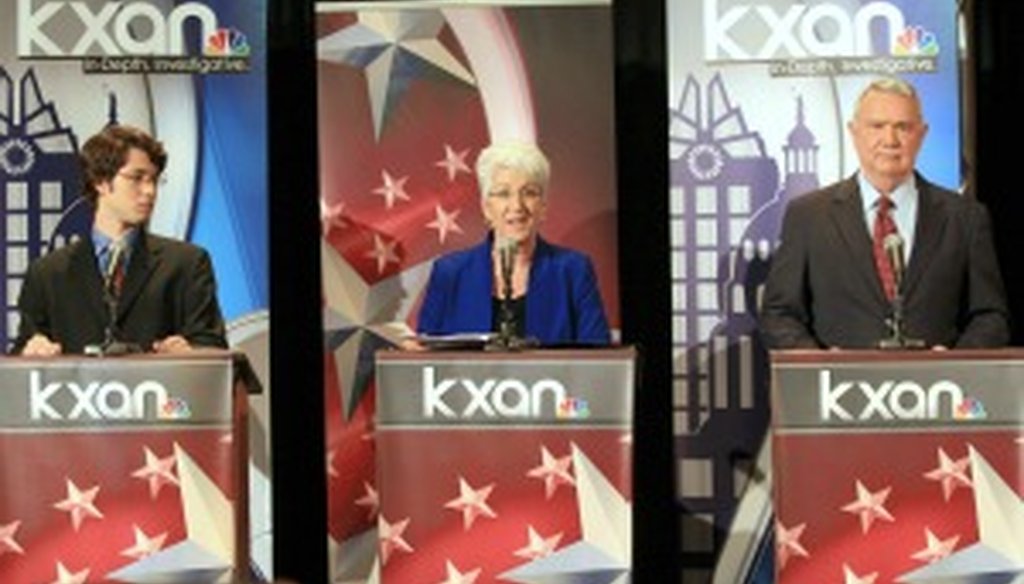

Our only agenda is to publish the truth so you can be an informed participant in democracy.
We need your help.


Austin mayoral candidates Clay Dafoe, Brigid Shea and Lee Leffingwell debate April 16, 2012. Jay Janner photo/Austin American-Statesman
CLARIFICATION, 11:20 a.m. April 26, 2012: This fact check incorporates corrected 2010 and 2011 revenue figures provided by Capital Metro after the article’s publication. The changes do not affect our rating.
As Austin’s candidates for mayor took part in a debate April 16, 2012, Clay Dafoe urged less spending on trains and more money for bus service.
"Basically, what we’re having is people riding a bus, subsidizing this expensive, romanticized train that really doesn’t qualify or fit the needs of Austin," said Dafoe, a tax preparer, in the debate televised by Austin’s KXAN-TV, Channel 36.
Although Austin is again considering a plan for electric-powered "urban rail," its current system is diesel-powered commuter trains, in operation since 2010. Capital Metro, Austin’s transit agency, runs MetroRail between Leander and downtown Austin roughly 6 a.m. to 7:30 p.m. weekdays and, with hours added in March, until midnight Friday and 4 p.m. to midnight Saturday. A one-way fare to ride the whole distance is $2.75.
MetroBus is Capital Metro’s catch-all term for its 65 regularly scheduled bus routes criss-crossing Austin and in some cases extending out to suburbs like Leander, Manor and the Wells Branch area. A day pass, entitling a rider to board all but the agency’s 900 series express bus, costs $2; an express bus day pass costs $5.50.
From data that Cap Metro spokeswoman Erica McKewen emailed to us, including a link to the agency’s 2012 budget, it’s clear MetroBus earns more than MetroRail.
For 2012, Cap Metro predicted MetroRail will provide 400,000 rides and earn $909,939, while MetroBus will provide 25.4 million rides and earn $8.8 million in fares.
But expenses are considerably higher than revenue from fares. MetroRail’s 2012 operating costs were estimated at $11.8 million for 2012, and MetroBus expenses at $106.6 million.
So neither system is covering its own expenses -- nor is either intended to. Most of Cap Metro’s budget comes from a sales tax on purchases made in the agency’s service area, McKewen said.
A chart on Cap Metro’s website shows the agency expects 80.3 percent of its 2012 revenues will come from that 1 percent tax, which its board raised from 0.75 percent in 1995.
Thus, the tax is expected to bring in $153.2 million (out of $191 million total revenues) for 2012. Cap Metro’s 2011 year-end financial report says that in 2011, sales tax revenues were $151.2 million (80 percent of total $189.3 million), compared with $141.9 million (74 percent of total $191.9 million) in 2010, the year MetroRail began running.
McKewen said that Cap Metro’s April 23, 2012, deal to outsource bus operations is not expected to result in the system becoming profitable.
Are bus riders "subsidizing" the trains, in any sense?
Not by the usual definition of "subsidy," which is a grant of money. McKewen said no block of funds is transferred from the bus services to the train services.
If we use a more colloquial sense of "subsidize," we might say, for example, that if one unit of a company turns a profit while another loses money, the first unit is "paying" to keep the other afloat. That’s not the case here: Neither the rail nor buses turn a profit.
Our ruling
Cap Metro’s buses pull more of their weight, so to speak, than its trains. But neither system turns a profit, and besides, most of the agency’s budget comes from sales tax, not tickets to ride.
So if anybody’s "subsidizing" the trains, it’s Austin-area shoppers, though that group likely overlaps with bus riders. We rate Dafoe’s statement False.
Austin mayoral candidates’ debate, KXAN-TV, video, April 16, 2012
Telephone and email interviews with Clay Dafoe, Austin mayoral candidate, April 20-24, 2012
Telephone and email interviews with Erica McKewen, communications specialist for Capital Metropolitan Transportation Authority, April 19-24, 2012
Austin American-Statesman blog post, "Urban rail details likely to emerge in late May," April 20, 2012
Capital Metropolitan Transportation Authority, Capmetro.org train schedules, accessed April 24, 2012
Capital Metropolitan Transportation Authority, "Fiscal Year 2012 Approved Budget," accessed April 24, 2012
Capital Metropolitan Transportation Authority, "2012 Budget Basics," accessed April 24, 2012
Capital Metropolitan Transportation Authority, 2011 "Comprehensive Annual Financial Report," March 26, 2012
Austin American-Statesman news story, "Cap Metro OKs $520 million in contracts, outsourcing all bus service," April 23, 2012
In a world of wild talk and fake news, help us stand up for the facts.
